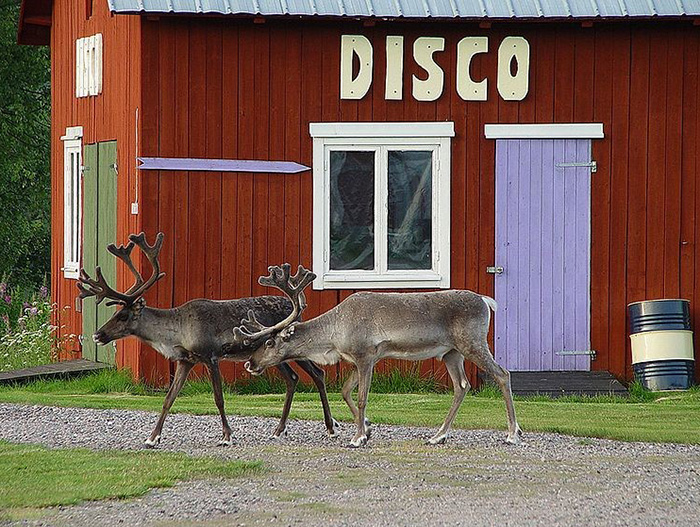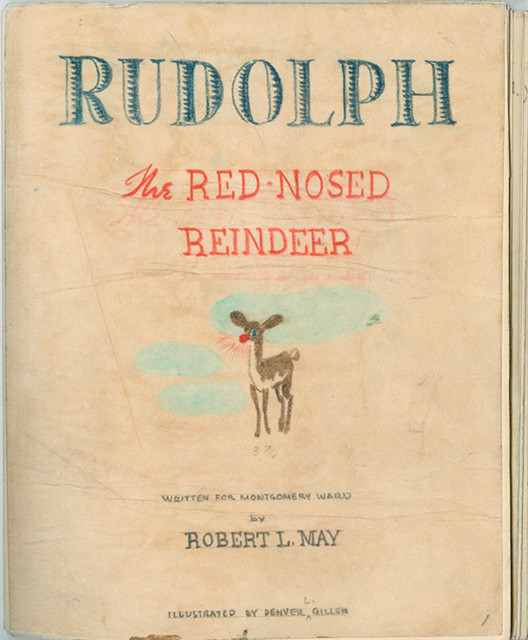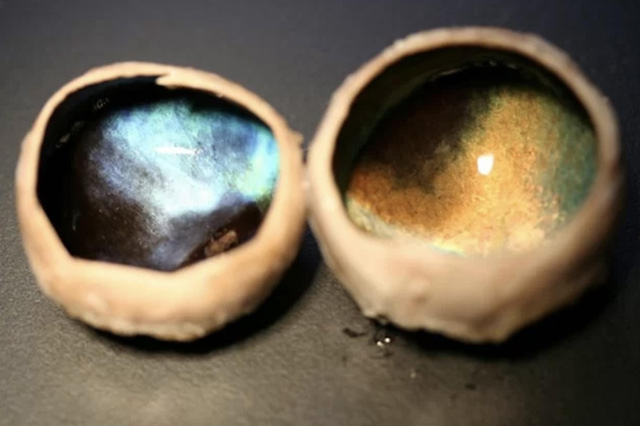
Maybe only Santa’s reindeer can fly—but regular reindeer come pretty close.
They can fly over the tundra at 50 miles an hour, covering more than 20 miles a day.
Their annual migrations span 3,000 miles, the longest of any land animal.
And they’re spectacularly adapted for that life:
Their eyes change color depending on the season. In their summer above the Arctic Circle, with nearly 24 hours of sun, their eyes turn gold, to reflect the harsh light.
In the dark months of winter, their eyes turn blue, to let in as much light as possible.
Their eyes also can see ultraviolet light.
This makes the snow even brighter, but against it, some important things appear black: The fur of predators, who might otherwise be camouflaged. And lichen, the reindeer’s primary winter food.
What their eyes can’t see is red. Like many mammals, they’re red–green colorblind; both colors appear brown.
While this would have made it hard to follow Rudolph’s nose, their noses are pretty amazing in their own right. They’re lined with capillaries, to warm the frigid air before it enters their lungs.
They’re also the only deer species where both males and females grow full antlers. The males’ drop off after mating season ends in November. But the females’ stay on through winter, into the spring calving season.
This means that if Santa’s reindeer do, in fact, have antlers on Christmas Eve, they’re all females.
Background

Synopsis: In 1939, Robert May wrote a Christmas story that was published by the Montgomery Ward department store to delight their customers, young and old. May’s brother-in-law turned the story into a song, and during Christmas week 1949, Gene Autry’s recording hit No. 1 on the Billboard pop singles chart. Over the past 80 years, the story of the lonely reindeer with a remarkably bright beacon of a nose has become modern American Christmas folklore. How do the lyrics of the song actually play out in nature?
“Rudolph the Red-Nosed Reindeer had a very shiny nose, and if you ever saw it you would even say it glows.”
- A red nose for a reindeer is not impossible: reindeer regulate their internal body temperature through their nasal passages.
- Compared to humans, reindeer have 25 percent more capillaries carrying oxygenated red blood in their muzzles to warm arctic winter air before it gets to their lungs.
- Reindeer have fur all over their bodies, even on their hooves. Like many other mammals, reindeer can’t sweat, but their nasal architecture helps to cool them down in the summer.
- Reindeer typically have dark brown noses, but Rudolph’s overactive red nose is described as being the color of beets and holly berries—possibly a good thing for summer temperature regulation, but the color could expose him to hypothermia by causing him to lose body heat too rapidly.
- We don’t know exactly why Rudolph’s red nose glows, but we do know that, like all the other reindeer, his eyes reflect shiny gold in summer, switching to shiny blue in winter.
- Reindeer eyes have a mirror-like tissue behind the retina called the tapetum lucidum, like many pets and wild animals whose eyes reflect light. This tissue is very important for nocturnal creatures because it amplifies light and allows them to see more detail in the dark.
- Reindeer have adapted to the extreme light levels in the Arctic by changing the sensitivity of their retina each season, the only mammals known to do so.
- In the constant bright light of summer, mirror-like gold reindeer eyes reflect most of the light directly back out through the retina.
- In the endless darkness of winter, dark blue reflection scatters more light into photoreceptors in the retina, increasing sensitivity to low blue and violet light. The constant dilation because of darkness is thought to increase eye pressure by preventing fluid in the eyeball from draining normally. The pressure compresses the tapetum lucidum, reducing space between collagen fibers in the tissue, thus reflecting shorter wavelengths of blue light.
- The winter shift reduces visual acuity compared to summer, but the trade-off provides them with better night vision and helps them to detect moving predators as well as food sources.
“All of the other reindeer used to laugh and call him names—they never let poor Rudolph join in any reindeer games.”
- The reindeer must have had other reasons to be bullies, because reindeer can’t even see red.
- Like dogs and most other nonprimate mammals, reindeer can’t distinguish among red, orange, and green; in humans, this is known as “red–green colorblindness.”
- Rudolph’s glowing nose would probably have looked light brown, as would Santa’s suit. Festive red- and green-colored Christmas packaging would appear as various shades of muddy brown. Reindeer, like dogs, can, though, see blue and yellow.
- Reindeer are usually very social and form very large herds of adult males, females, and calves for defense against predators. To make it hard for predators to isolate an individual, they tighten the herd up and run continuously in a large circle, with more-vulnerable individuals protected in the center. Being a lonely Arctic reindeer would have been very dangerous for Rudolph.
- After the popularization of the 1949 song, “reindeer games” became synonymous with exclusive games limited to members of cliques.
“Then one foggy Christmas Eve, Santa came to say: "Rudolph, with your nose so bright, won't you guide my sleigh tonight?"
- Santa certainly would have benefited from the light of a bright red nose: longer-wavelength red light penetrates fog more effectively.
- More helpful in guiding the sleigh would be Rudolph’s blue-reflecting winter eyes, which are tailored specifically to see in the extremely low light of the long winter nights at the Arctic Circle.
- Reindeer are the only large mammals that have cones adapted to receive even shorter wavelengths of ultraviolet light (down to 320 nm), along with blues and violets. Humans see wavelengths from about 400 nm (violet) to 700 nm (red).
- In humans and most other mammals, the lenses won’t let UV light into the eye, clouding up to protect the retina in a condition known as snow blindness that is sometimes permanent. Many arctic mammals, however, have adapted to allow UV into their eyes.
- Snow reflects 90 percent of the UV light that hits it, compared to the only few percent reflected from snow-free areas. The snow-covered landscape would be extra-bright from a reindeer viewpoint—with a few important exceptions.
- When researchers used UV cameras to examine snowy scenes that reindeer typically see, they noticed that fur and urine absorb UV—and stand out clearly as black in the snow! Using their special vision, reindeer can clearly see the fur and urine of potential predators, like Arctic wolves, even if they are camouflaged to the human eye.
- The primary winter food source for reindeer is lichen—which also absorbs UV and comes across as black in the snow.

- Reindeer can’t really fly a sleigh, but they can run up to 50 mph (80 kph).
- Aside from tracking Santa’s sleigh on Christmas, scientists also have used satellite imaging to track reindeer migrations from calving grounds in the northern tundra southward to boreal forests. Reindeer travel farther than any other land-based mammal, covering up to 3,100 miles (6,000 km) per year, averaging 23 miles (37 km) per day.
“Then how the reindeer loved him as they shouted out with glee: ‘Rudolph the Red-Nosed Reindeer, you'll go down in history!’”
- “Reindeer” is the common name for Rangifer tarandus, also known as “caribou” in the U.S.
- Reindeer migrated to the Arctic about 10,000 years ago.
- Rudolph is probably a female reindeer!
- Reindeer are the only deer species in which males and females both grow antlers. Wild males fight each other with their antlers during the mating season, and then lose them in November. Females keep theirs until after spring calving, giving them an advantage over males in fights for food while they are pregnant. So Rudolph, Dasher, Dancer, Prancer, Vixen, Comet, Cupid, Donner and Blitzen might all have been females if they still had their antlers in December!

